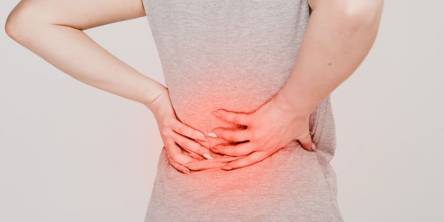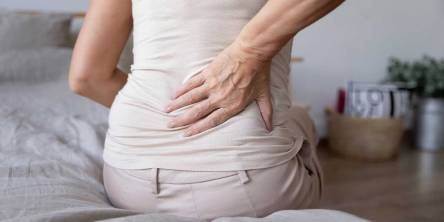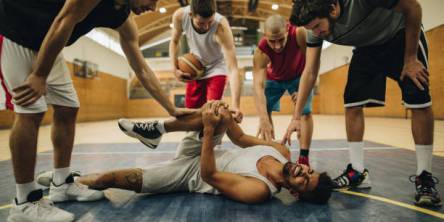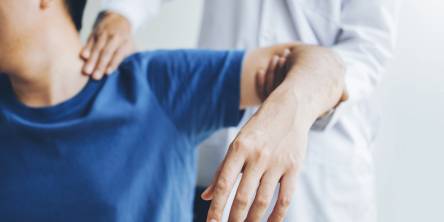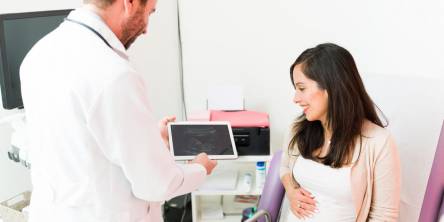Thoracic Herniated Disc: Symptoms and Treatment
According to the American Association of Neurological Surgeons, approximately 75%-85% of Americans have back discomfort at some point in their lives. Upper back pain is commonly caused by small injuries such as muscle strain, sprain, bad posture, inappropriate lifting, or twisting, although it is not always caused by a herniated disc.
A thoracic herniated disc is much less likely to occur than a lumbar (lower back) or cervical (neck) herniated disc due to the thoracic spine's stiffness and the thoracic vertebrae's size. They can, however, occur.
Thoracic Herniated Disc Symptoms
Pain is the most prevalent sign of a thoracic herniated disc. A herniated disc in the thoracic spine can cause pain in the mid-back, unilateral or bilateral chest wall, or abdominal areas around the damaged vertebrae. If the lower thoracic region is implicated, pain may radiate to one or both lower extremities.
Numbness, tingling, or muscle weakness in one or both lower extremities are other possible symptoms.
Radiculopathy
Radiculopathy — pain that radiates down the nerve and away from the spine — can occur if the herniation compresses a thoracic spinal nerve. If you have a thoracic herniated disc, you may have pain, numbness, and tingling around your rib cage or upper abdomen.
A large herniated disc can compress the spinal cord within the spinal canal, causing numbness, tingling, or weakness in one or both legs, as well as bowel and bladder dysfunction and, in severe cases, paralysis.
The most prevalent causes of herniated discs in the thoracic spine are degenerative disease and trauma.
Treatment Options
Here are the most common options for thoracic herniated disc treatment:
Home Remedies and Prevention
A herniated disc might interfere with daily activity and sleep. There are several basic things you may do at home to help with pain relief:
- It's difficult to figure out how to sleep with a herniated disc. Place a small pillow beneath your head and legs to maintain your spine neutral and avoid placing pressure on any herniated discs.
- Back discomfort can be relieved by sitting in chairs with a solid back to support the spine.
- Avoid lying down.
- Short bursts of light activity are recommended.
- Lifting, twisting, or straining the back should be avoided.
- Apply an ice pack or cold compress to the affected area every two hours for 15 to 20 minutes.
Here are some practices to do to keep your discs healthy:
- Quit smoking or never start
- Keep a healthy weight
- Exercise regularly
Conservative and Alternative Treatments
Medications, spinal traction, dry needling, and epidural spinal injections can be used in conjunction with physical therapy to manage pain and let the body heal on its own.
An orthopedic or neurologic physical therapist can design a safe exercise program to help reduce discomfort, improve strength and posture, and promote mobility.
Massage and acupuncture can help with pain management.
Common medical treatments include over-the-counter or prescription medications such as acetaminophen and nonsteroidal anti-inflammatory drugs (NSAIDs) such as ibuprofen. Oral steroids can also reduce inflammation, which can help with pain relief. Opioids are most effective in the acute phase and should not be used long-term.
Surgical Options
A thoracic herniated disc does not usually necessitate surgery. However, if you've been experiencing severe pain that isn't responding to conservative therapy and/or is causing neurological abnormalities, you may need to consider surgery.
The purpose of surgery is to remove the herniated disc that is compressing a nerve root. A spine specialist will decide whether surgery is the best option. Surgical options will vary depending on the size, kind, and location of the injury, but the most common are:
- Discectomy
- Laminectomy
- Spinal fusion
Because of the close closeness to the spinal cord, surgical repair entails a risk of complications, including worsened neurological outcomes.
Similar Articles
Despite the name, don’t worry, heartburn has nothing to do with your heart. Rather, it's a burning feeling in your esophagus, which is the 10-inch tube that connects your mouth and stomach.
Numerous natural cures for back pain can help you minimize your pharmaceutical use or supplement your current medical treatment. Here are some of the natural pain-relieving strategies to see which one works best for you.
Cycling is more than just a sport or a leisure activity; it's a way of life for many. Whether you're an avid cyclist or use your bike for transportation, there's a lot to love about this two-wheeled mode of getting around. But with great rides come great responsibilities, particularly when it comes to safety.
Have you observed any changes in your movement, speech, or thinking? If this is the case, you may wonder if the changes need a visit to a neurologist. A neurologist is a doctor who diagnoses and treats disorders affecting the brain, spinal cord, and nerves
Lower back pain is a common and often severe issue that affects millions of individuals throughout the world. While many of us have dealt with lower back pain at some point in our lives, there are a few interesting facts about this illness that you may not be aware of. In this article, we'll delve into seven intriguing and lesser-known facts about lower back pain, shedding light on its causes, impact, and potential solutions.
When it comes to the most common basketball injuries, some are widespread for players of all ages and ability levels, while others are only seen at the highest levels.
When you think about sports injuries, you generally think of football, basketball, or soccer. All three of these sports demand players to put their bodies on the line regularly. Contact is widespread, and tackling is an essential component of the game of football.
In the fast-paced world of healthcare, OBGYN practices face numerous challenges, from providing quality patient care to managing complex billing processes. As medical professionals strive to focus on patient well-being, the administrative burden of billing and coding can be overwhelming.
Spine surgery is a crucial procedure that needs thorough post-operative care and rehabilitation. Recovery from spine surgery can be difficult, but with the appropriate attitude and support, you can improve your healing and regain strength and mobility


